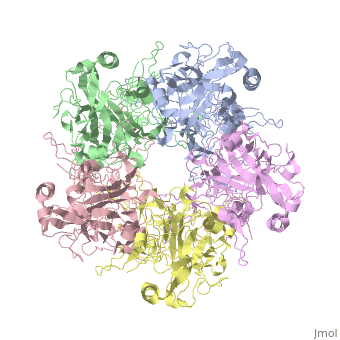Major capsid protein L1
From Proteopedia
(Difference between revisions)
| Line 11: | Line 11: | ||
== Relevance to Human Health and Disease == | == Relevance to Human Health and Disease == | ||
| - | Human Papillomavirus (HPV) has over 100 known strains that have been classified into 16 different groups (A-P), and it can be distinguished into two infectious groups: cutaneous HPV and mucosal HPV. Infection of HPV causes papillomas on the site of infection, which can include (but not limited to) the anus, vulva, scrotum, penis, and groin. The human papilloma virus is one of the most common sexually transmitted diseases in the world <ref="Murray">Murray, Patrick R., Ken S. Rosenthal, and Michael A. Pfaller. "Papillomavirus and Polyomavirus." Medical Microbiology. Philadelphia: Elsevier/Saunders, 2013. 445-450.</ref>. | + | Human Papillomavirus (HPV) has over 100 known strains that have been classified into 16 different groups (A-P), and it can be distinguished into two infectious groups: cutaneous HPV and mucosal HPV. Infection of HPV causes papillomas on the site of infection, which can include (but not limited to) the anus, vulva, scrotum, penis, and groin. The human papilloma virus is one of the most common sexually transmitted diseases in the world <ref name="Murray">Murray, Patrick R., Ken S. Rosenthal, and Michael A. Pfaller. "Papillomavirus and Polyomavirus." Medical Microbiology. Philadelphia: Elsevier/Saunders, 2013. 445-450.</ref>. |
| - | HPV can be transmitted on fomites, with asymptomatic shedding promoting transmission. HPV can be acquired from direct contact with small breaks in the skin or mucosa, from sexual intercourse, or when an infant passes through an infected birth canal <ref="Murray"/>. | + | HPV can be transmitted on fomites, with asymptomatic shedding promoting transmission. HPV can be acquired from direct contact with small breaks in the skin or mucosa, from sexual intercourse, or when an infant passes through an infected birth canal <ref name="Murray"/>. |
| - | Different HPV types are tissue specific, causing different disease presentations. That is why Gardasil targets nine different types of HPV: Types 6, 11, 16, 18, 31, 33, 45, 52, and 58 <ref name="types"/>. In particular, types 16 and 18 can trigger the development and late onset of cervical carcinoma, a cancer typically seen in sexually active females that is asymptomatic for several months and upwards to a decade before ultimately leading to infertility. HPV-6 and HPV-11 can also cause cervical carcinoma but are more renowned for causing condyloma acuminatum along with oral and laryngeal papillomas. HPV-31, HPV-33, HPV-45, HPV-52, and HPV-58 are all less common causative agents of cervical intraepithelial neoplasia and cancer <ref="Murray"/>. | + | Different HPV types are tissue specific, causing different disease presentations. That is why Gardasil targets nine different types of HPV: Types 6, 11, 16, 18, 31, 33, 45, 52, and 58 <ref name="types"/>. In particular, types 16 and 18 can trigger the development and late onset of cervical carcinoma, a cancer typically seen in sexually active females that is asymptomatic for several months and upwards to a decade before ultimately leading to infertility. HPV-6 and HPV-11 can also cause cervical carcinoma but are more renowned for causing condyloma acuminatum along with oral and laryngeal papillomas. HPV-31, HPV-33, HPV-45, HPV-52, and HPV-58 are all less common causative agents of cervical intraepithelial neoplasia and cancer <ref name="Murray"/>. |
Revision as of 15:52, 16 November 2016
| |||||||||||
References
- ↑ 1.0 1.1 Zhai L, Tumban E. Gardasil-9: A global survey of projected efficacy. Antiviral Res. 2016 Jun;130:101-9. doi: 10.1016/j.antiviral.2016.03.016. Epub, 2016 Apr 1. PMID:27040313 doi:http://dx.doi.org/10.1016/j.antiviral.2016.03.016
- ↑ https://www.gardasil9.com
- ↑ 3.0 3.1 http://www.hpvvaccine.org.au/the-hpv-vaccine/how-does-it-work.aspx
- ↑ 4.0 4.1 https://www.medicines.org.uk/emc/medicine/19016
- ↑ Harper DM, Vierthaler SL, Santee JA. Review of Gardasil. J Vaccines Vaccin. 2010 Nov 23;1(107). pii: 1000107. PMID:23805398 doi:http://dx.doi.org/10.4172/2157-7560.1000107
- ↑ doi: https://dx.doi.org/10.1128/JVI.77.8.4818-4826.2003
- ↑ http://dx.doi.org/10.1016/j.virol.2013.05.038
- ↑ http://www.uniprot.org/uniprot/P03101
- ↑ https://www.merck.com/product/usa/pi_circulars/g/gardasil/gardasil_ppi.pdf
- ↑ doi: https://dx.doi.org/10.4161/hv.3.4.4309
- ↑ http://www.fda.gov/BiologicsBloodVaccines/Vaccines/QuestionsaboutVaccines/ucm096052.htm
- ↑ 12.0 12.1 12.2 Murray, Patrick R., Ken S. Rosenthal, and Michael A. Pfaller. "Papillomavirus and Polyomavirus." Medical Microbiology. Philadelphia: Elsevier/Saunders, 2013. 445-450.
Proteopedia Page Contributors and Editors (what is this?)
Morgan Smith, Michal Harel, Jessica Troutman., Maximillia Jackson., Jaime Prilusky

